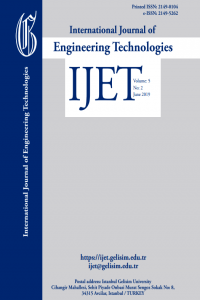Using Five Machine Learning for Breast Cancer Biopsy Predictions Based on Mammographic Diagnosis
Logistic Regression Linear Discriminant Analysis, Random Forest, Quantitative Discriminant Analysis, Support Vector Machine,
___
- Department of Health and Human Services Centers for Disease Control and Prevention, World Cancer Day, February 3, 2015.
- Department of Health and Human Services Centers for Disease Control and Prevention, United States Cancer Statistics, Technical Notes 2007.
- American Cancer Society, Cancer Facts & Figures 2016, Atlanta, Georgia, American Cancer Society, pp. 1– 63, 2016.
- Simes RJ. Treatment selection for cancer patients: application of statistical decision theory to the treatment of advanced ovarian cancer. J Chronic Dis, 38:171-86, 1985.
- Maclin PS, Dempsey J, Brooks J, et al. Using neural networks to diagnose cancer J Med Syst, 15:11-9, 1991.
- Cicchetti DV. Neural networks and diagnosis in the clinical laboratory: state of the art. Clin Chem, 38:9-10, 1992.
- Petricoin EF, Liotta LA. SELDI-TOF-based serum proteomic pattern diagnostics for early detection of cancer. Curr Opin Biotechnol, 15:24-30, 2004.
- Bocchi L, Coppini G, Nori J, Valli G. Detection of single and clustered micro calcifications in mammograms using fractals models and neural networks. Med Eng Phys, 26:303-12, 2004.
- Zhou X, Liu KY, Wong ST. Cancer classification and prediction using logistic regression with Bayesian gene selection. J Biomed Inform, 37:249-59, 2004.
- Dettling M. Bag Boosting for tumor classification with gene expression data. Bioinformatics, 20:3583-93, 2004.
- Wang JX, Zhang B, Yu JK, et al. Application of serum protein finger printing coupled with artificial neural network model in diagnosis of hepatocellular carcinoma. Chin Med J (Engl), 118:1278-84, 2005.
- McCarthy JF, Marx KA, Hoffman PE, et al. Applications of machine learning and high-dimensional visualization in cancer detection, diagnosis, and management. Ann N Y Acad Sci, 1020:239-62, 2004.
- L. Breiman. Bagging predictors. Machine Learning, 24:123–140, 1996.
- P. Buhlmann and B. Yu. Analyzing bagging, The Annals of Statistics, 30:927–961, 2002.
- A. Buja and W. Stuetzle. Observations on bagging. Statistica Sinica, 16:323–352, 2006.
- G. Biau, F. Cerou, and A. Guyader. On the rate of convergence of the bagged nearest neighbor estimate. Journal of Machine Learning Research, 11:687–712, 2010.
- ISSN: 2149-0104
- Başlangıç: 2015
- Yayıncı: İstanbul Gelişim Üniversitesi
Robiul Islam Rubel, Md. Kamal Uddin, Md. ZAHİDUL ISLAM, Md. Rokunuzzaman
David OYEWOLA, Danladi HAKİMİ, Kayode ADEBOYE, Musa Danjuma Shehu
